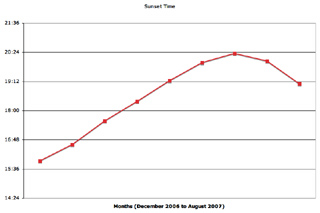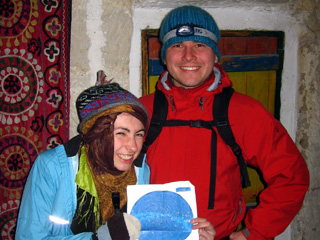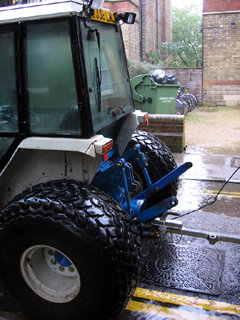About once a week, someone finds my blog while searching for a review of this jacket. As far as I can tell, there are none on the internet so far. The following is meant to serve as a correction to that.
Today has given me a good opportunity to try out the Mountain Equipment Co-op (MEC) Aegis jacket that I got this summer in really severe rain conditions. People who remember Dennis Nedry’s attempted escape to the dock in Jurassic Park will have some idea what I am talking about, though this is cool temperate rain rather than the lukewarm tropical variety. As in the past, it has proved both exceptionally weatherproof and quite breathable, especially with ventilation flaps open. A waterproof jacket in which you can cycle vigorously without getting drenched or steamed is a valuable thing, especially in a place that does such a good job of combining cycling as the major form of personal transport and rather wet winters. As far as I can tell on the basis of three months’ usage, this is the finest technical jacket I have ever owned.
The things I like most about the Aegis jacket:
- It is very waterproof, and works well as part of a layering system. 3-ply Gore-Tex XCR is about the best you can do, in terms of breathability, water resistance, and durability.
- It has lots of nice refinements: taped seams, a good adjustable hood, etc. The fact that even the under-arm zippers are of a very waterproof variety shows attention to detail. The hood works tolerably underneath a bike helmet, though at considerable cost of lost field of vision.
- The entire Gore-Tex membrane is lined on the inside, improving breathability and durability quite a lot.
- The pockets are waterproof enough that I do not fear for electronics inside, even in really awful conditions.
- Unlike my previous jacket, the elastic wrist cuffs do not seem to saturate with water.
- Capable enough for serious outdoor activities in very wet conditions, but also reasonable for wearing every day. That is, if you don’t mind announcing pretty loudly that you are from the west coast of North America.
- It is made in Canada, which is pretty amazing for a garment.
- Compacts well, for being carried around in a pack. (Weight: 730g)
- In my experience, MEC has an excellent record of dealing with any problems that crop up in their products. They replaced an MCR WhisperLite stove that had been used for more than a week (during the second Bowron Lakes trip), because it had a fuel flow problem.
And those I like least:
- Since it is just a shell, the fabric can feel a bit tarp-like, when it is worn without an insulating layer underneath.
- The rigidity of the collar takes some getting used to, though it really does keep out the rain, even when the hood is not being used.
- The bulges produced by gear in the four pockets are quite unflattering. At least, they are when you carry a wallet, a small digital camera, liner gloves, and personal audio gear in it almost all the time.
- There are no hip-level pockets. Sometimes, this forces me to put my least important electronics in enormously less waterproof pant pockets.
- The price is pretty high (C$340), though that becomes less of an issue if it lasts five years or longer, as I fully expect it to.
People with questions can feel free to contact me, or leave a comment. I will probably post some updates when I’ve had the jacket longer and used it in more varied conditions.
[Update: 31 October 2007] This is one tough jacket. Earlier tonight, I was thrown forward off my bicycle onto pavement. I scraped along for a little bit, bruising my arm and ribs. Upon inspection, the jacket shows no visible sign of having suffered from the incident.
After nearly a year of wearing this jacket almost daily and in all conditions, it is still in great shape overall. Buying it was a good choice




